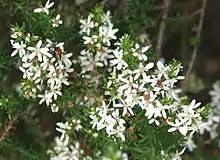Olearia ramulosa
Olearia ramulosa, the twiggy daisy-bush, is a species of flowering plant in the family Asteraceae.[2] It occurs in New South Wales, Victoria, South Australia and Tasmania.[2]
| Olearia ramulosa | |
|---|---|
 | |
| Scientific classification | |
| Kingdom: | |
| (unranked): | |
| (unranked): | |
| (unranked): | |
| Order: | |
| Family: | |
| Tribe: | |
| Genus: | |
| Species: | O. ramulosa |
| Binomial name | |
| Olearia ramulosa | |
| Synonyms | |
|
Aster ramulosus Labill. | |
Jacques Labillardière described the twiggy daisy bush as Aster ramulosus in 1806, in volume 2 of his Novae Hollandiae Plantarum Specimen, from material collected in Tasmania.[3] The species name, derived from the Latin rama "branch", means having many small branches.[4] German botanist Christian Gottfried Daniel Nees von Esenbeck called it Diplostephium ramulosum in 1832,[5] and Swiss botanist Augustin Pyramus de Candolle called it Eurybia ramulosa in 1836.[6]
Alternative common names are oily bush and water cypress.[7]
Olearia ramulosa is a shrub that reaches 1.6 m in height. The narrow leaves are alternately arranged along the stems and measure 2–8 mm long by 0.8–2.5 mm wide with entire margins. The flowers appear from October to May. The daisy-like flower heads are 1–2 cm in diameter, with 2–13 white or mauve rays and a central yellow disc.[2] Flower heads can appear in great numbers and be highly conspicuous.[4]
The plant is eaten by caterpillars of the moth species Amelora milvaria.[8] Bees, beetles, and less commonly flies and wasps have been recorded visiting flowers in a Tasmanian field study.[9]
Olearia ramulosa can be propagated by seeds or cuttings of new growth that has hardened. It can be grown in dry or temperate climates and is frost-hardy in sunny or part-shaded spots. Pruning can invigorate it and it can be grown as a low hedge.[4]
References
- "Olearia ramulosa". Australian Plant Name Index (APNI), IBIS database. Centre for Plant Biodiversity Research, Australian Government, Canberra. Retrieved 2009-03-22.
- "Olearia ramulosa (DC.) Benth". PlantNET – New South Wales Flora Online. Royal Botanic Gardens & Domain Trust, Sydney Australia. Retrieved 2009-02-22.
- Labillardiere, J.J.H. de (1806). Novae Hollandiae Plantarum Specimen (in Latin). 2. Paris, France: Ex typographia Dominæ Huzard. p. 51.
- Elliot, Rodger W.; Jones, David L.; Blake, Trevor (1997). Encyclopaedia of Australian Plants Suitable for Cultivation. 7: N–Po. Port Melbourne, Victoria: Lothian Press. p. 93. ISBN 0-85091-634-8.
- Nees von Esenbeck, C.G.D. (1832). Genera et Species Asterearum (in Latin). p. 193.
- De Candolle, Augustin Pyramus (1836). Prodromus Systematis Naturalis Regni Vegetabilis (in Latin). 5. Paris, France: Sumptibus Sociorum Treuttel et Würtz. p. 270.
- Cunningham, Geoff M.; Mulham, William E.; Milthorpe, Peter L.; Leigh, John H. (1981). Plants of Western New South Wales. Sydney, New South Wales: NSW Government Printing Service. p. 644. ISBN 0-7240-2003-9.
- Common, I.F.B. (1990). Moths of Australia. CSIRO publishing. ISBN 9780643102712.
- KINGSTON, ANDREW B.; QUILLAN, PETER B. (2000). "Are pollination syndromes useful predictors of floral visitors in Tasmania?" (PDF). Austral Ecology. 25 (6): 600–09. doi:10.1111/j.1442-9993.2000.tb00065.x.